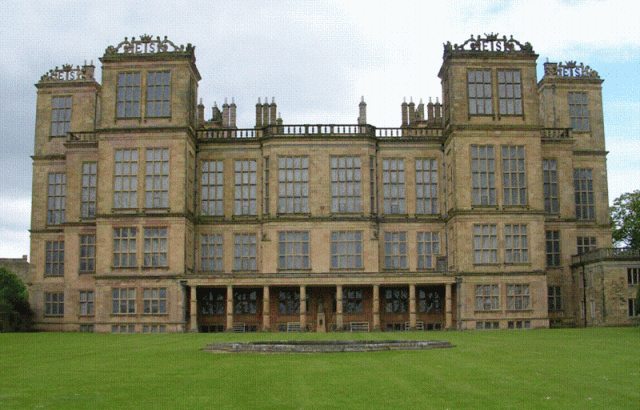From The Wall Street Journal:
Bess of Hardwick, though little known today, was one of the most remarkable women of the 16th century: determined, brave, attractive (when she chose to be) and richly talented. One wouldn’t call her “nice,” but then “nice” is not an adjective that one would apply to many notable figures in Tudor England, perhaps indeed to none.
With no advantage of birth, Bess was, for a time, on terms of friendship with both Queen Elizabeth and Mary Queen of Scots, Elizabeth’s great rival. She married four times, each husband a notch or two higher in the social register. She had eight children, two of whom died in infancy; she secured good marriages for the others. One granddaughter, Arbella Stuart, had a claim to both the English and Scottish thrones. Bess had a passion for property and a passion for building. Hardwick Hall, her last house—now visible from the M1 motorway as it moves through Derbyshire in north-central England—is, as the British writer Kate Hubbard notes, “at once romantic and austere, ostentatious and restrained.” Ms. Hubbard’s biography, “Devices and Desires,” engagingly traces Bess of Hardwick’s astonishing rise, her sometimes fraught experience amid Tudor power struggles, and her legacy as a patron of architecture and the decorative arts.
. . . .
Her third marriage, to a West Country landowner named William St Loe, was oddly enlivened by his brother’s failed attempt to poison her and thus improve his chances of inheritance. That marriage was followed, upon William’s apparently natural death, by her grandest alliance, to George Talbot, 6th Earl of Shrewsbury. The Talbots were great noblemen before the Tudors ever reached the throne: The first earl, known as the “English Achilles,” had been a celebrated commander in the Hundred Years’ War with France.
Bess’s new husband owned estates across the North and Midlands, and, as Ms. Hubbard relates, “was not just a great landowner, but an industrialist-in-the-making, a producer of coal, iron, lead and glass.” The marriage was a business deal, soon cemented by marriages between their respective sons and daughters from earlier marriages. It began in affection, though it would end years later in acrimony.
In 1568, Mary Queen of Scots—who had been forced to abdicate from the Scottish throne, had raised an army and been defeated—took refuge in England, hoping that her cousin Elizabeth would help restore her to power. Elizabeth had no such intention: Mary, a Catholic, had a claim to the English throne as well. So Mary was, in effect, put under house arrest, though she had her own servants and was treated as a queen. Bess’s new husband, Shrewsbury, was given the responsibility of acting as Mary’s keeper, in his own houses and castles.
Shrewsbury—“a worrier and a neurotic,” in Ms. Hubbard’s phrase—found his guardianship onerous, all the more so because Elizabeth was often late in reimbursing him for what he spent on Mary and her household. At first Mary and Bess were on good terms; they did embroidery together and gossiped happily, the Scots queen being eager to have firsthand information about her English cousin. But relations cooled, and Mary compiled what is known as the “Scandal Letter,” addressed to Queen Elizabeth and reporting the unflattering things that Bess had supposedly said about her. The letter was apparently never sent; had Elizabeth received it, Bess would have been in deep trouble. As it was, Bess came to distrust Mary, giving credence to rumors that Shrewsbury was having an affair with her. (Ms. Hubbard is sure he wasn’t.) After 15 years Shrewsbury was relieved of his guardianship but was required, a few years later, to preside over Mary’s execution after she has been found guilty (on dubious evidence) of approving a plot to assassinate Elizabeth.
Link to the rest at The Wall Street Journal
And here’s a photo of Hardwick Hall:

I wonder why the WSJ thinks that Mary’s conviction was “on dubious evidence”? You can certainly argue that Walsingham should have nipped the Babington Plot in the bud rather than waiting for Mary to incriminate herself, but incriminate herself she certainly did. Calling it treason was dubious but whatever you call it she was still plotting to assassinate Elizabeth.
If it were gray instead of mustard it could pass for public housing or a soviet hotel.
http://media.gettyimages.com/photos/the-central-building-of-the-kgb-on-lubyanka-square-moscow-17th-june-picture-id105657334?s=594×594
I think that all that glass was an ostentatious display of wealth. It is certainly not one of the better looking English country houses, though it is much improved by bright sunlight when the stone – what there is of it – glows, and yes it is then really golden; I assume it’s sandstone.
However, if you are in Derbyshire, Chatsworth is a definite improvement.
In an age without electricity being able to afford all that glass made life quite a bit brighter. 😉
And if you could afford the glass you could afford the coal as well because you’d really need good heating in winter.
I’ve always wanted to know more about Bess of Hardwick, so I’ll look into this book. I once recommended learning more about her and Elizabeth I, and their estates, to a writer who seemed to think that nobles and royals just randomly had lots of money.
Though, I don’t see the “ostentatious” part for Hardwick Hall. It does look grim and Gothic. The style just leaves me cold. But then, I’ve always favored cabriole over “clean lines,” and Hollywood Regency over mid-century modern.
I see what the OP means by ostentatious and restrained. Rather a grim, Gothic place.
Granted, I’ll bet that on the inside there is lots of light (look at all the windows!) — but, where are the doors? And what’s with that portico? The whole thing needs a good coat or three of white, if you ask me.